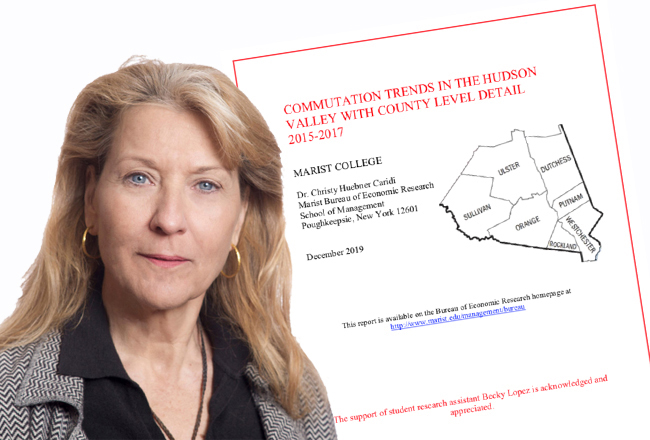More than 24% of Hudson Valley residents who work, commute to their primary jobs in New York City, according to a report from Marist College”™s Bureau for Economic Research.
The report, “Commutation Trends in the Hudson Valley 2015-2017,” showed that “labor market efficiency” continued to decline. It’s the relationship between the demand for jobs within a given geographic region, in this case the Hudson Valley, and the supply of jobs. As of 2017, 58.6% of all Hudson Valley residents who worked had their primary jobs located in the region. Only 43.5% of the workforce was able to work in the county in which they lived. In Westchester, the figure was 44.4%.
The director of the bureau, Christy Huebner-Caridi, told the Business Journal that the established trends and her personal observations suggest that when data from 2018 and 2019 becomes available they likely will show little change from what”™s in the report
Caridi, an assistant professor of economics, prepared the report along with research assistants who are students at Marist. “This is the newest data available. Once new data is released about this time next year, I doubt very much you”™re going to see much of a change,” she said.
The report indicated that while there have been efforts to attract employers to the Hudson Valley, Manhattan still is a jobs magnet.
“Essentially when it comes to the entire region, we”™re still very dependent on jobs in New York City. So many people from the city have moved up here. Starting in about 2000 to 2001, there was a migration from the southern Hudson Valley counties. People that were living relatively close to the city moved further away from the city as housing prices started to increase.”
The 2017 data showed that 140,843 Westchester residents worked in New York City, representing 36.1% of Westchester residents with jobs. For Rockland, the number was 29,695, 22.6% of that county”™s workforce. The study found that 21.6% of Putnam”™s workforce, 9,479 people, commuted to New York City.
Caridi said that as more people from New York City have moved into Westchester and other parts of the Hudson Valley, they”™ve brought New York City salaries with them. She said that people who live and work in the region and are not earning at the same level are having a more difficult time with rising costs. “The data paint a picture of the complex, full-spectrum of employment.”
Caridi said the data indicated that some people have not fully recovered from the economic distress of a decade ago.
“On the one hand, we saw an increase in the number of residents who hold more than one job, which speaks to people cobbling together several part-time jobs in an effort to create the wages of a full-time job. Then, in Westchester County, we”™re seeing a majority of residents commuting into the city for higher salaries,” she said. The data showed that 89,778 Hudson Valley residents held more than one job in 2017, although whether it was two or more jobs could not be determined.
She said that the dependence on New York City for jobs will continue.
“I can”™t see anything in the data that would indicate there is going to be a big change. In fact, if anything, I think we should anticipate more people moving up from the city into the Hudson Valley, and certainly the northern Hudson Valley rather than the southern Hudson Valley again taking into consideration housing values and the cost of living. With respect to transportation, Metro-North is going to have to put more monies into the train system,” Caridi said.
She said special attention should to be paid to providing ample parking at train stations. “In this part of the world, we go to Poughkeepsie or Beacon, take your pick. It”™s very, very difficult to find parking spaces.”
The report said that the most important working-age demographic in the Hudson Valley region was the 30 to 54 age group. The report said that group had the highest labor-force participation rate in 2017 at 69.6% or 499,061 people working, accounting for more than 53.2% of all primary jobs held.
The age group 55 and up had 248,690 Hudson Valley persons employed in 2017, up by 4,942 since 2015. In the age group age 29 and younger, the number was 190,425, up from 180,936 in 2015.




















